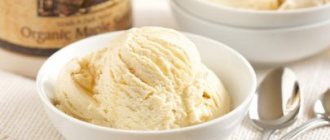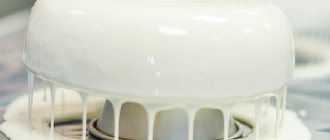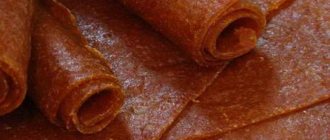Cottage cheese is a valuable product that can be found on the table in almost every home, especially if there are small children. But can you always be sure of the naturalness of this product, especially if it is purchased in a store? Isn’t it easier to make your own cottage cheese at home from milk?
Necessary:
- milk – 3 l.
Preparation time: 1-3 days for souring, 20 minutes for cooking.
Calorie content – 160 kcal.
To make delicious and fresh cottage cheese, you will need milk. Of course, if possible, it is better to use natural milk, not from the store. You can buy it in the nearest village or market, as well as in milk machines - special machines in which you can buy fresh milk brought from dairy farms.
If it is not possible to buy natural milk, then you can use milk purchased at the store. It makes no difference how this milk is stored: in a bottle, in a pack or in a plastic bag.
So, we decided on milk. Now you can start preparing the cottage cheese. Milk should be poured into a three-liter jar or directly into a saucepan for further souring. It is better to take an enamel pan or made of stainless metal.
The milk will turn into curdled milk the next day if it happens in the summer, or on the third day in the winter season. You can check the readiness of the curdled milk by sticking a spoon into it. Ready yogurt is a homogeneous dense mass. In store-bought milk, the curdled milk rises closer to the surface, while the whey remains at the bottom.
Now you can put the pan on the fire, but do not bring it to a boil. You can remove the dishes from the stove when the curds separate from the whey.
For the next step, take a tall pan, a colander and gauze folded in four layers. The resulting whey mass is poured into a colander. Gradually, the whey drains into the pan, and the curd remains in the gauze.
When all the liquid has gone, you can transfer it to a plate or other container. The curd turns out tender, with layers.
If you wait too long for the whey to drain (for example, by leaving the curd in a colander on gauze overnight), it may turn out to be dry and crumbly. From the initial volume of milk it is possible to obtain approximately 600-800 g of curd.
Cottage cheese made from milk with lemon juice
Necessary:
- homemade milk – 2 l;
- lemon – 1 pc. or 1/3 teaspoon citric acid.
Cooking time: half an hour.
Calorie content – 170 kcal.
If you need to quickly make cottage cheese from milk at home, you can use lemon, or rather, its juice. The pan with milk is placed on the fire, and at this time the juice is squeezed out of the lemon.
As soon as the milk begins to boil, you should immediately pour lemon juice into it. Instead, you can take citric acid, first diluting it in ½ cup of warm water.
Then you need to pour in lemon juice or citric acid and wait until the milk begins to curdle. This means the pan can be removed from the heat. Pour the resulting mass into a colander to drain the whey. The resulting curd is tender, soft, and pasty. But it is completely unsuitable for baking.
Cottage cheese made from milk with sour cream
Some housewives prefer to add sour cream to milk when preparing cottage cheese to obtain a more tender and fatty product.
This cottage cheese can be prepared for small children who are just starting to get acquainted with dairy products.
How to make homemade cottage cheese from milk and sour cream? There are two ways to prepare such a product.
First way
Necessary:
- milk - 1 cup;
- sour cream – 0.5 tablespoon.
Preparation time: 18 hours for souring, 40 minutes for cooking.
Calorie content - 193 kcal.
First you should boil the milk, then add sour cream to it. Place all this in a small saucepan in a warm place overnight. In the morning, sour milk must be heated over a fire until the whey separates. Then place it on a napkin folded in four to drain the whey. The curd is ready. It turns out tender. finely grained.
Second way
Necessary:
- milk (sour) - 3 l;
- sour cream - 500 g.
Cooking time: 20 minutes.
Calorie content - 193 kcal.
Place sour milk (preferably country milk) in a saucepan in a water bath and heat until whey forms. Then you should pour in the sour cream, but do not stir the mixture with a spoon, so as not to disturb the structure of the cottage cheese. Then pour it onto a gauze napkin placed in a colander. The result is a fatty and very tasty cottage cheese.
Recommended similar content
Save the article to social networks:
Making cottage cheese at home is not at all difficult. It is prepared from milk, store-bought or farm milk, with the fat content of your choice. Cottage cheese can also be prepared from ready-made kefir. For children, you can make cottage cheese from baby milk and kefir.
Making cottage cheese at home is not at all difficult. It is prepared from milk, store-bought or farm milk, with the fat content of your choice. Cottage cheese can also be prepared from ready-made kefir.
For children, you can make cottage cheese from baby milk and kefir.
What is the advantage of homemade cottage cheese over industrial cottage cheese and why prepare cottage cheese yourself, waste time on it, if you can just go in and buy, choosing cottage cheese products to your liking in the store?
Everything is simple here: you do not add additives and preservatives that are unnecessary for our body. In addition, at home you can prepare the amount of cottage cheese that you need at the moment. If you have children in your family, then with some simple technology you can always have fresh cottage cheese.
You can also make various dishes from homemade cottage cheese.
How to make cottage cheese from yogurt
Curdled milk is the easiest fermented milk product to prepare.
In order to get curdled milk, you only need to take milk and put it in a warm place. To speed up the formation of curdled milk, you can add to milk: per 1 liter - 100 ml of kefir or 1 tablespoon of sour cream or yogurt.
After the milk turns into curdled milk, you need to separate the curd mass from the whey.
To do this, you need to pour the curdled milk into a bag made of several layers of gauze or other linen, then hang it. This will separate the curds from the whey, which will take about half a day.
To speed up the process of preparing cottage cheese from yogurt, it must be heated. Do not bring the product to a boil or boil!
Then you should cool the mass and place it in a colander with gauze or other fabric. Apply pressure (press) to get drier cottage cheese. You can also hang it in a gauze or linen bag.
The longer the curd is left hanging or under pressure, the denser and drier it turns out.
How to prepare calcined cottage cheese
It is very simple to prepare such cottage cheese at home. Cottage cheese prepared in this way has low acidity and is especially suitable for dietary and baby food.
We will need:
- Milk – 2 liters,
- Calcium lactic acid – 3 teaspoons
(12 g).
Preparation:
Calcium lactic acid is sold in the pharmacy in powder form. It must be dissolved in a small amount of water, for example, 3-4 tablespoons of water. Bring fresh milk to a boil, turn off the heat and add dissolved calcium lactic acid while stirring constantly.
At the same time, the milk curdles. This mass must be cooled and strained through cheesecloth or other fabric to separate the whey from the curd.
The cottage cheese can be hung so that it drains better, or placed under pressure. From 2 liters of milk you will get 300-350 grams of cottage cheese.
2 ways to make cottage cheese from kefir
Warm way
Kefir must be placed in a warm place for faster separation of whey.
When the whey begins to separate, place the container with kefir in a water bath and heat it for better and faster separation of the whey from the curd mass. Then throw the mass into a gauze or fabric bag and hang it so that the excess whey is drained.
You can use a faster method, which involves directly heating the cottage cheese, for example, in a saucepan over low heat, until a curd mass and whey form. This mass should not be brought to a boil.
Cold way
Place 1 liter of kefir in a bag or package in the freezer for 2-3 days, then remove the frozen kefir from the bag.
Place it in a colander with gauze and wait until the whey drains and you are left with tender and very tasty cottage cheese.
The process of making cottage cheese at home takes a minimum amount of time, cost and effort.
However, the product you prepare yourself will be significantly different from similar competitors offered to customers by modern manufacturers.
Homemade cottage cheese contains much more useful substances, which, unfortunately, are present in minimal quantities in factory versions.
Homemade cheese made from cottage cheese and milk
You can make your own cheese from milk.
First method (without eggs)
Necessary:
- milk – 1 l;
- cottage cheese – 1 kg;
- butter - 100 g;
- soda - 1 teaspoon;
- salt - to taste.
Calorie content - 336 kcal.
Beat the cottage cheese with a blender and add to boiling milk. Stirring regularly with a spoon, wait until it boils and cook for about 10 minutes over medium heat.
If you cook the cheese for more than 10 minutes, it will be hard; if you cook it for less, the cheese will turn out soft.
After removing the pan from the heat, you need to pour the contents onto cheesecloth spread in a colander. To make the liquid faster than glass, you need to take the gauze by the edges and twist it with a rope.
The still hot cheese should be transferred to another container, add softened butter, salt and soda to make the cheese more porous. You need to beat with a blender again.
Transfer the resulting mass into a stainless steel pan and put on fire. The cheese mass, stirring continuously, needs to be heated so much that the contents move away from the walls of the dish.
Then the pan should be removed from the heat to cool. The warm mass is transferred to a container greased with oil, covered with cling film and put in the refrigerator to harden.
Second method (with the addition of eggs)
Necessary:
- milk – 2 l;
- cottage cheese – 2 l;
- eggs – 2 pcs.;
- butter - 200 g;
- soda – 1 tablespoon;
- salt - to taste.
Cooking time: one hour.
Calorie content - 339 kcal.
To make homemade cheese, put cottage cheese in a saucepan and pour milk into it, then put it on the stove. Stirring evenly with a spoon so that the curd does not stick to the bottom, heat the mixture until whey forms. Then the mass needs to be thrown onto a piece of gauze folded in half to drain the liquid.
Place the resulting cottage cheese in a stainless steel bowl, add eggs, softened butter, soda and salt to taste. Now you can start cooking the cheese. The mixture should be constantly stirred with a wooden spoon.
As soon as it becomes viscous and sticky, you can remove it from the heat. The hot cheese should then be poured into a cup or container and covered with cling film once it has cooled slightly. To obtain a denser structure, the cheese can be pressed with a press. After 3 hours the cheese can be eaten.
Technology for producing cottage cheese at home and the best recipes
As we wrote above, there are a huge variety of recipes for making cottage cheese, and each of them involves its own technology.
Let's describe a couple of the simplest of them - they allow you to produce a product as quickly as possible.
A simple recipe for making cottage cheese No. 1
Fresh milk needs to be poured into a small saucepan and placed in a warm place - you can just leave it on the table. The pan must be kept warm for at least 30 hours , without touching the milk during this entire period - this will deteriorate the quality of the curd curd.
After the specified time, the milk will turn into curdled milk and whey liquid. Now you need to put the pan on the stove over very low heat. The curdled milk needs to be heated, but it should not be brought to a boil.
To better control the temperature, you can use a water bath - place a saucepan with fermented milk in another larger saucepan with water, and the water should reach no more than the middle of the saucepan with yogurt.
If fermented milk is overheated, the curd may become too hard, causing it to crumble, and if the curdled milk is not heated enough, the curd will likely turn out sour, since the whey will not separate well enough.
During heating, the milk mass should not be stirred with a spoon - this will disrupt the process of whey separation.
During heating, you need to periodically check the temperature by simply touching the pan to prevent overheating.
You need to heat until the characteristic curd clots and clear whey appear, that is, about half an hour. After this, the pan must be removed from the heat and left to cool - it will take about six to eight hours until it cools completely.
Then you need to put the cottage cheese with a slotted spoon on a sieve, or pour the contents of the pan into a jar through cheesecloth, after which you should leave the cottage cheese for a while to drain.
If the cottage cheese was placed in gauze, it must be hung over the sink or bathtub; if in a sieve, it must be placed above any container so that the liquid has somewhere to drain.
Until the cottage cheese is completely ready, it should drain for about an hour and a half: if you leave it for a longer period, the product may become excessively dry.
A simple recipe for making cottage cheese No. 2
This technology allows you to get ready-made cottage cheese even faster .
You need to pour the milk into a jar, put a few tablespoons of sour cream or kefir in there (about 50 grams per liter of milk), and leave it in a warm place for fermentation.
Adding fermented milk products will give the cottage cheese a special taste, and in addition, it will significantly speed up this process - depending on the temperature, ripening can take from 12 hours to a day. The milk should not be stirred during fermentation.
When the milk mixture turns into curdled milk, you will need to take a clean saucepan, place a jar in it and pour in enough water so that it is approximately at the same level with the curdled milk. After which you need to remove the jar and put the pan on the fire.
After bringing the water to a boil, you need to turn off the heat and place a jar of fermented milk in a saucepan with hot water. Cover the jar with a lid and leave for about half an hour.
After the specified time has passed, the jar must be removed from the water and allowed to stand for another 40-45 minutes. After this, the contents of the jar should be poured onto cheesecloth and the resulting curd clot should be hung over the bathtub or sink for two hours.
Important to remember
- To get full-fat cottage cheese, it is better not to skim the cream from village milk;
- It is better to store cottage cheese and homemade cheese in glass or enamel containers, covered with a lid, but under no circumstances in a plastic bag. This way the cottage cheese will retain its freshness longer;
- You can freeze cottage cheese by putting it in the freezer, but it will no longer be as healthy;
- If it is impossible to store homemade cheese in the refrigerator, you can extend its freshness by wrapping it in a clean cotton cloth, previously soaked in salt water and thoroughly wrung out. It is better to keep such cheese in a cool, dark place;
- From the whey remaining after making cottage cheese, you can make pancakes or knead dough.
Anyone can make cottage cheese or cheese from milk at home with their own hands. All you need is desire, time and adherence to cooking technology.
Another option for making cottage cheese from milk at home can be found in the following video.
Description
Good day, dear readers and guests!
How to make cottage cheese at home? Many people think that making cottage cheese at home is difficult. Today I will tell you and show you how to make cottage cheese at home SIMPLY!
Homemade cottage cheese is prepared in different ways. I won’t go into depth about who cooks and how, I’d rather tell you my recipe, or rather two.
This may be strange, but there is no recipe for homemade cottage cheese on my website. I'm correcting myself, girls. And the recipe appeared thanks to our reader, Daria! It is at Dasha’s request that I am writing a recipe for homemade cottage cheese for everyone. After all, who doesn’t want to have breakfast with fresh homemade cottage cheese in the morning!
My main product in making cottage cheese is homemade milk. Through natural fermentation, milk turns into sour milk. In different localities it is also called differently - yogurt, sour milk. But I remember from childhood, we called sour milk kislyak. That is, real.
How to cook:
I would like to note that not everyone has the opportunity to purchase high-quality homemade milk. In this case, you can use store-bought milk. The main thing is that it was fat. Take with a high percentage of fat content. Don’t forget that the consistency and taste of such cottage cheese will be different from that of homemade cottage cheese.
So, homemade milk can be poured into a saucepan or wide bowl. Most often I use a three-liter jar. This milk also turned sour in a jar, but we drank some of the yogurt, but made cottage cheese from the rest.
Leave the milk to sour at room temperature, covered with a light cloth. I usually do this in the evening. In the summer, milk turns sour within a day. In winter, this process can take two days. But then choose a warm place for milk - a battery is ideal.
This may be too long for you! Then you can speed up the process of milk souring by adding a couple of spoons of sour cream or sour milk to warm milk (room temperature). I don’t recommend adding yogurt, you will get the same yogurt. Only homemade and in large quantities.
Well, my milk has gone sour. It's time to make cottage cheese from it. Yes, cottage cheese made from fresh yogurt can be stored in the refrigerator for up to 5 days. Of course, even after these days it can be consumed in food. But it’s better to use this cottage cheese for baking. For example, fry, bake, and much more.
When the milk sours, sour cream forms on top. I'm taking it off. From a 3-liter jar you can collect approximately 300-400 grams. sour cream. But when the milk has soured in a saucepan, a smaller layer of sour cream is formed. I also collect it and bake it for my family, or you can cook the pie in a slow cooker. Or like this.
Look at the consistency of sour milk - you just want to reach in and scoop it up with a spoon. Mmm!
We put this bowl on the fire, on a very low fire. Do not touch the bowl for the first 5 minutes, but then you need to take a slotted spoon or spoon and start stirring our yogurt quietly. To warm it all up, stir the contents of the bowl or pan from time to time. Many people cut it with a knife, but I’m so used to doing it with a slotted spoon that it turns out no worse.
Heat the pan with yogurt to 70 ºС. (putting your hands on the pan will make you hot). My two liters took 20 minutes to warm up. If you have a larger volume of curdled milk, you will need more time. About 40 minutes. And again, don’t forget to stir it. And do it without fanaticism.
It is important not to overheat the yogurt or underheat it. Overheated yogurt will make dryish cottage cheese. And if it is not heated, you will get the wrong cottage cheese. In addition, the serum will last no more than a day. It will start to stink and will be unusable. Well, properly heated cottage cheese has a transparent greenish whey and it can stand in your refrigerator for more than a month. Would you like a recipe to cook with whey? Please. , you can simply drink while adjusting your stomach.
How do you know when the cottage cheese is ready? It settles to the bottom of the pan, and the whey turns out to be a greenish transparent hue. Turn off the heat and leave our container alone until it cools completely.
After cooling, the top whey can be poured into jars, but the rest of the pan along with the cottage cheese is poured into a colander lined with gauze.
This is the serum.
I needed moist cottage cheese, so I couldn’t stand it under pressure or under my own weight. She immediately put it into use (prepared it).
But if you hang the cottage cheese and leave it for 12 hours (place a bowl for the draining whey), all the whey will drain and you will get a cool homemade granular cottage cheese!
Friends, I use this recipe to prepare homemade cottage cheese for my family. If you cook with me, you are great and thank you very much for that!
What about the second recipe for making cottage cheese? No, I haven't forgotten. The process of souring milk for future cottage cheese is the same. Simply standing and heating the curdled milk does not take place on the stove or in a water bath, but in the oven. A friend of mine shared this recipe with me, from whom I always buy homemade (excellent) sour cream for my custom-made cakes. She makes it for sale, so she prepares it in big batches at once. Place bricks on the bottom of the gas oven.
Place jars (3 three-liter jars) with sour milk on these bricks and cover them with lids (without rubber bands). Turns the fire on almost full blast and keeps them there for about an hour. After this, the fire is turned off, but the can is not taken out, but left until warm.
Then continue as usual. Drains onto large gauze or special fabrics and leaves to drain! Friends, I hope the recipe was useful to you. I wish everyone pleasant chores in the kitchen and don’t forget to leave your comments! PS Friends, note: to keep the cottage cheese longer in the refrigerator, put a couple of pieces of sugar on it. Store cottage cheese in a glass container with a lid. Either in foil or thick parchment.
Homemade cottage cheese is the most delicious because it is always fresh and natural. You can prepare it in different ways. The final result depends on the quality of the milk. Some people like cottage cheese fatty, with an oily structure, while others like a dietary product, with a small amount of fat and a sour taste.
Read more about how to make cottage cheese at home to suit every taste in the recipes.
Homemade cottage cheese using “hot”, “warm” and “cold” methods. 5 options
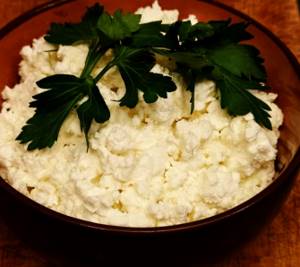
Homemade cottage cheese using the “warm” method. Photo by the author.
In the article on cottage cheese, I noted that making your own cottage cheese is not difficult. And I decided to give several accessible recipes for making homemade cottage cheese, which I use myself, noting the important points of technology and the benefits of the resulting cottage cheese. Here you will also learn about the properties of the serum and options for its use.
Whenever I make cottage cheese, I use whole milk . I always save the whey from the cottage cheese and then use it widely. To do this, I place the cottage cheese in a colander covered with several layers of gauze, under which a container is placed to collect the whey. To make the cottage cheese dry and crumbly, you need to tie the ends of the gauze and hang the knot over the sink or pan for several hours for self-pressing. I do not consider the method of preparing cottage cheese from milk with lemon juice, because this is a method of preparing not cottage cheese, but paneer, a traditional Indian cheese.
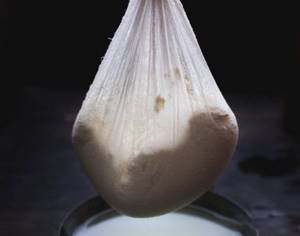
Cottage cheese in gauze
"Hot" methods
Cottage cheese cooked with intense heating loses all fermented milk flora. In principle, it is quite simple to prepare cottage cheese without preserving the fermented milk flora. And there are plenty of such recipes on the Internet. I myself periodically make cottage cheese this way when I urgently need it. But the yield of such cottage cheese is less than with traditional “warm” preparation; the cottage cheese turns out to be coarser, drier and not “alive”. Also, for the “hot” method you will need ampoules of calcium chloride 10%, which can be purchased at the pharmacy.
1 option
- Milk 2 l
- Kefir 3.2% 1 l
- Calcium chloride 10% 2 ampoules
Pour the milk into the container or bowl of the multicooker, dilute ampoules of calcium chloride in it, slowly heat it while stirring to 80-85 * C and pour kefir along the wall as if around the milk. Coagulation occurs with the formation of flakes and clots. Leave for 20-30 minutes, stir and, making sure that all the milk has curdled, pour into a colander lined with 2-4 layers of gauze. If the milk has not completely curdled, reheat the milk. Pour into a colander lined with gauze. Then we hang the gauze by the ends so that the curd is pressed out and the whey is completely drained.
Option 2
- Milk 3 l
- Calcium chloride 10% 2 ampoules
Leave the milk in a warm place for 1-3 days. Don't stir it. The time depends on the room temperature: the warmer it is, the faster the milk will sour. To speed up the process, you can add 2 tablespoons of sour cream or yogurt to the milk. The sour milk will look like a soft, thick jelly, and whey will begin to appear around it. Place the milk in a saucepan, add calcium chloride and place over low heat. After 20–25 minutes from the start of cooking, curds will begin to form in the pan. Remove the pan from the heat and let stand for the same amount of time. Then transfer the cottage cheese to a colander with gauze and hang it to drain. A variation of this method could be heating in the oven. Preheat the oven to 100° and place a pan with the mixture in it. It is necessary to monitor the process until the whey separates, on average it will take an hour and a half. When the mixture has cooled, place it in a colander with gauze. The cottage cheese turns out more tender than when making it on the stove.
Option 3
- Kefir 3.2% 1-1.5 l
- Calcium chloride 10% 1 ampoule
Kefir can be replaced with fermented milk or a mixture of milk with kefir or yogurt. Pour into a deep microwave-safe container and heat in the microwave at 700 W for 5 minutes or 600 W for 7-8 minutes. Leave for another 2-3 minutes and drain in a colander.
The yield of cottage cheese using these methods is approximately 550-600 g from 3 liters of milk. But there is no living fermented milk flora in it, which significantly reduces the benefits of its use. In addition, with option 1, the milk does not have time to ferment, so it contains a lot of lactose, which should be taken into account by people with lactose intolerance. Cottage cheese using this method is excellent for further thermal culinary processing : for dumplings, cheesecakes, casseroles, fillings in cheesecakes and pies, desserts. But such cottage cheese can also be made “alive” . Just add any fermented milk product to the cooled cottage cheese: fermented baked milk, yogurt, sour cream, yogurt. Stir or beat with a mixer and leave for several hours in the refrigerator. It will be even more beneficial to eat “live” cottage cheese with fruits, vegetables or herbs.
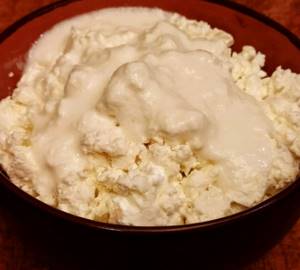
Cottage cheese with yogurt
"Warm" method
Using this method, cottage cheese retains all the benefits of “live” fermented milk product . In general, there are 2 main “warm” methods for producing cottage cheese: acid and rennet-acid. The second method requires the addition of rennet or pepsin, which I use to make homemade cheese. But not everyone has these enzymes. Therefore, it is easier to prepare using acid production technology. Unpasteurized milk must be pasteurized. I do everything in a slow cooker . Pasteurization of milk is carried out at 80*C with a holding time of 15 minutes. Leave to cool to 37*C. Pasteurized milk, on the contrary, is heated to this temperature. Next, you need to add a starter consisting of mesophilic and thermophilic lactic acid streptococci in a ratio of 1: 1 in an amount of 5% of the milk weight. This starter is sold on the Internet. But you can use fermented baked milk or Mechnikov’s curdled milk for this purpose; they have the same composition, it’s simpler and more affordable. You can also use sour cream; it has a similar composition of bacteria.
- Milk 3l
- Ryazhenka or Mechnikovskaya yogurt 180-200 g
Mix well and leave to ferment for 6-8 hours at a temperature of 34-35*C. When the milk has fermented, slowly raise the temperature to 38 * -40 * and leave for 30 - 40 minutes. Then, to speed up the release of whey, the curd must be cut into small pieces, which will significantly increase its surface. The curd is cut into cubes about 2x2 cm in size with a long knife. The cut clot is left alone for another 30 minutes. During aging, serum is intensively released from it. Gently stir the grain from the edges to the center, the grain will compact, releasing the whey. Place the pan or multicooker bowl into a bowl of cold water; I place it in the sink to cool the cottage cheese sharply. The grain will sink to the bottom. Drain the whey down to the grain, then place the grain in a colander lined with gauze and hang it by the ends for 1-2 hours so that the curd compacts itself. Place the cottage cheese in the refrigerator. The yield of such cottage cheese is 700 - 800g from 3 liters. The cottage cheese is tender and has all the benefits of “live” cottage cheese described in the article. Such cottage cheese can and should be eaten without heat treatment. You can also enrich it with sour cream, yogurt, fruits, grated vegetables, herbs, with “healthy” or “fragrant” jams.
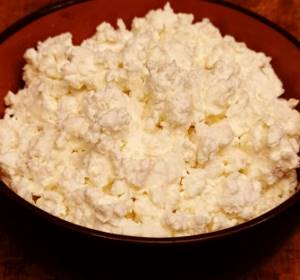
Cottage cheese in the “warm” way
"Cold" method
And this is generally the most “lazy” method and the most tender cottage cheese as a result.
- Kefir in a bag 1 (2) l
We buy kefir, preferably in a bag. Put it in the freezer for 8-10 hours. Remove from the bag by cutting the bag. Place frozen kefir on gauze folded 4 times and hang it by the ends over the pan at room temperature until completely defrosted. During the thawing process, the whey will drip into the pan, leaving a tender, airy curd in the gauze. At the same time, it will also be a “live” curd, which is perfect for baby food or as cream cheese for desserts or on a sandwich. The only drawback is that it is made instantly from 1 liter, rarely from 2. But it also requires virtually no personal time.
Properties and use of serum
Whey is a storehouse of useful substances, a complete product with a whole range of healing properties. The composition includes lactose, glucose, amino acids (albumin, lactoglobulin and evoglobulin), minerals (potassium, calcium, phosphorus, sodium, magnesium, iron, medb, boron), choline, beta-carotene, vitamins C, A, E, PP, biotin (vitamin B7), B vitamins, lactic, nucleic and citric acids, a wide range of fatty acids, lactic acid bacteria. In fact, the properties of whey are similar to the properties of cottage cheese, only they are less pronounced. Whey improves protein metabolism and hematopoiesis, reduces the risk of viral diseases. It helps restore normal intestinal microflora. Restores water-salt balance, is used to reduce intoxication of the body, is indicated after courses of chemotherapy to restore the mucous membrane of internal organs. It has a positive effect on the cardiovascular and circulatory systems, lowers blood pressure, and has a diuretic effect. Recommended for use in diabetes mellitus. Used to treat dermatological problems, gynecological diseases, atherosclerosis, and brain disorders. The serum has an excellent whitening effect and tightens the skin, smoothing out fine wrinkles. The serum in the masks acts as an antioxidant, protecting the epidermis from aggressive external factors. It has proven itself to be an excellent hair mask, eliminating dandruff and improving hair growth and structure. I use it to make smoothies with vegetables, cook pancakes, bread, focaccia, pastries, desserts, and use it to make Adyghe cheese. I use it to make cocktails with added juice or herbs. I use it widely as a facial and hair care product.
Choose a method and cook for health, youth and beauty! To your health and bon appetit!
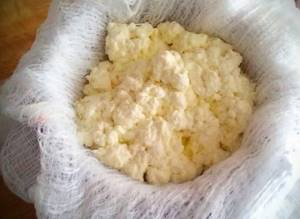
Cottage cheese in a colander with gauze

Cottage cheese with berries and fruits
Step-by-step recipes for homemade cottage cheese from milk - basic technological principles
Cottage cheese is made from natural (whole) milk. As you know, milk contains natural milk protein – casein. At a temperature of 10-12°C, milk ripens within 12-15 hours. During this time, the structure of the protein changes, and the process of natural ripening begins.
Then the milk is heated. Whey is separated and a clot is formed: under the influence of temperature, casein fibers coagulate (contract), pushing liquid (whey) out of the cells. In production conditions, this process is called pasteurization. It occurs at 63-65°C for 20 minutes. As the temperature increases, the pasteurization time shortens.
In fact, milk coagulation occurs at a lower temperature - 40-45 ° C, but in dairy plants, where huge volumes of raw milk collected from different farms are processed, the increase in pasteurization temperature is due to sanitary standards. When there is absolute confidence in compliance with sanitary standards during milking, in the sterility of the utensils and in the satisfactory maintenance of the animal, homemade milk can simply be heated until the whey begins to separate, and then removed from the stove and allowed to stand until completely cooled.
There is a pattern: the higher the milk pasteurization temperature, the worse the quality of the cheese grain. This is why sour boiled milk never forms a normal curd, although, again, under production conditions soft cheeses are produced from milk processed by high-temperature pasteurization. But there are special technologies for this.
To make homemade cottage cheese, you can use some industrial secrets. Some details of industrial technology for making homemade cottage cheese from milk are in step-by-step recipes and useful tips.
How to make cottage cheese from pasteurized milk and kefir?
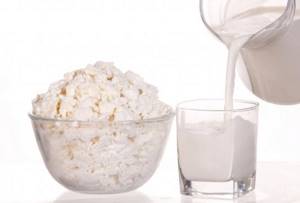
Cottage cheese made from pasteurized milk
- But if it happens that you do not have the opportunity to get milk that cannot be heat treated, then you should not be too upset
- You can also use a pasteurized product for cooking. Ordinary low-fat kefir will help you make delicious and healthy homemade cheese.
- It is this that will help separate the milk proteins from the whey and make a cheese mass out of them. In this case, you need to adhere to the correct proportions
- After all, if you overdo it with kefir, the cottage cheese will turn out to be quite unpresentable and will not have a very good structure
So: • Take at least 3 liters of pasteurized milk • Heat the milk to a boil • Remove the pan from the stove and add kefir to it (for 1 liter of milk 500 ml of kefir) • Add a little salt to the workpiece and put it on the fire again • When the cheese mass begins to separate whey, remove the pan from the stove and strain the mass • If you want the cheese to be denser, you can put it under a press for a couple of hours
Step-by-step recipe for homemade cottage cheese from fresh milk
Ingredients:
Homemade milk 3.5 l (1 bottle)
Sourdough - the amount depends on the type of fermented milk product or enzyme
Calcium chloride 5% 5 mg (1 ampoule)
Preparation procedure:
1. The first stage is the normalization of milk. Of course, it is difficult to obtain milk of the required fat content using home methods, but the process can be approximately adjusted. The main thing is that the milk is whole. Fat content affects taste and consistency. The industry produces low-fat cottage cheese with fat content of 9% and 18%. Choose your option and skim off the cream as needed.
2. Pour the milk into a saucepan and heat to 35-40°C.
3. Add the starter into warm milk and stir for 5-7 minutes. Leave the pan at room temperature. At the same time, add calcium chloride to speed up the curdling of the milk.
Usually, milk sours without adding starter culture within 7-8 hours. During this time, acidity increases, the product is enriched with lactobacilli, and acquires a characteristic taste. This is an acidic method of making homemade cottage cheese. It is more natural.
Adding sour cream and other fermented milk products speeds up the process by 2 times. Sour cream, yogurt, whey or yogurt is the most optimal way to ferment milk at home - these products can be found in every home. There is only one obligatory condition: fermented milk products must be prepared thermostatically from whole milk.
If desired, replace fermented milk products with pepsin or other enzymes. This is the second, acid-rennet method for preparing homemade cottage cheese from milk, which can be used by replacing sour cream with enzyme in step two of the step-by-step recipe.
4. When a clot appears, place the pan on the stove and heat the raw materials again, stirring, at a temperature of no more than 40-42°C. With strong heating, the quality of the cottage cheese will deteriorate. Fat and calcium will go into whey, and the cheese curd will noticeably decrease in volume and become dry. However, this option is also acceptable, but it’s not for everyone.
5. Break the resulting dense clot into small fractions to speed up the separation of liquid.
6. Place a sieve or colander on a tray, the capacity of which should be at least 3.5 liters, so that the whey does not overflow over the edge of the dish. Cover the sieve with gauze folded in four layers and carefully, gradually pour the fermented milk.
7. When the bulk of the whey has drained, tie the ends of a gauze napkin and hang it over the pan for some more time to compact the cheese curd and remove excess moisture from the product.
From the specified amount of homemade milk you can get 350 - 400 g of fresh cottage cheese.
How to make cottage cheese at home: 6 best recipes
Recipe No. 1: Cottage cheese from milk, classic recipe
Ingredients:
- 2 liters of homemade or store-bought milk.
How to make cottage cheese from milk:
- We put the milk in a warm place and wait for yogurt to form. This will take approximately three days. It all depends on the temperature in the room and the speed of fermentation. Important : do not put milk in the refrigerator to sour, it will become bitter and acquire an unpleasant odor. Also, don't stir it.
- To determine whether milk is sour, just take a closer look at its appearance. If it has turned into jelly, and whey floats along its edges, then you can already make homemade cottage cheese from it.
- Pour the curdled milk into a convenient saucepan and place on low heat. Cook for about fifteen minutes, and do not forget to stir constantly.
- Towards the end, you will notice the formation of curd lumps. Remove the pan from the heat and leave for another fifteen minutes.
- Pour the contents of the pan into a colander. We are waiting for the serum to drain from it.
- Homemade cottage cheese according to the first recipe is ready. The product yield from the specified amount of raw materials is about 0.4 kg.
The first homemade recipe is suitable for casseroles, cheesecakes and pancakes. Can also be consumed raw.
Recipe No. 2: How to make cottage cheese at home from milk without heating the raw materials
Ingredients:
- 2 liters of homemade or store-bought milk.
Method for preparing cottage cheese:
- We put the milk in a warm place to make yogurt (sour milk).
- We fold the gauze fabric several times and line the colander with it.
- Pour the curdled milk into a colander, tie the ends of the fabric into a knot and hang it for several hours.
- Homemade cottage cheese according to the second recipe is ready.
Homemade cottage cheese according to the second recipe will turn out tender and soft, and will surprise the most demanding gourmet.
Recipe No. 3: How to make cottage cheese at home from whole milk and lemon
This is a very quick recipe for making fermented milk product. Its main secret lies in lemon.
Ingredients:
- 2 liters of whole or store-bought milk;
- One lemon.
Detailed instructions:
- Place a saucepan with whole milk over medium heat and bring to a boil. If the milk is store-bought, then bring to a boil, but do not boil.
- Add the juice of one lemon. The required volume of juice for this amount of raw material is 60 ml.
- Add the citrus juice slowly and in a thin stream, while constantly stirring the mixture. Very soon you will notice how lumps of cottage cheese begin to form.
- Turn off the heat and remove the pan. Let the homemade cottage cheese cool slightly and transfer to a colander until the whey drains completely.
Recipe No. 4: How to make cottage cheese from kefir
Ingredients:
- One liter jar of kefir of any fat content.
How to make cottage cheese at home from kefir:
- Prepare two pans of different sizes. We make sure that the smaller pan fits into the larger one without any problems.
- Fill a large saucepan halfway with water. Place on the stove, turn the heat to medium, and bring to a boil. Then reduce the heat.
- Pour kefir into a second pan and place it in a pan of boiling water.
- After a short time, you will see curd lumps form and whey begins to release.
- Turn off the heat and wait 10 minutes. Pour the contents of the pan into a colander and wait until the whey has completely drained.
Homemade cottage cheese according to the fourth recipe is ready. The product yield from the specified amount of raw materials is 0.2 kg. It turns out quite dense and crumbly.
Recipe No. 5: Homemade cottage cheese from milk and kefir
Ingredients:
- One liter of fresh milk;
- One liter of kefir of any fat content.
How to make cottage cheese at home:
- Place the pan with milk over medium heat. Bring to a boil, but there is no need to boil.
- The first bubbles that appear signal the need to remove the milk from the heat.
- Add kefir into the hot milk in a thin stream and mix thoroughly.
- Leave the mixture until completely cooled and thickened.
- Place the cottage cheese in a colander and wait for the whey to drain.
The product yield from the specified amount of raw materials is 300 grams.
Recipe No. 6: How to make cottage cheese at home from frozen kefir
Ingredients:
- One liter jar of kefir.
Step-by-step recipe for homemade cottage cheese from sour milk
Ingredient:
Homemade curdled milk
It happens that the milk has already turned sour, and it needs to be “put into action.” If the product has not been boiled, then it is quite suitable for making homemade cottage cheese. This milk does not require any special additives.
Preparation:
1. The curdled milk needs to be heated. When the temperature rises to 40°C, milk protein coagulates. All this has already been described above, in the basic technological principles of producing homemade cottage cheese from milk.
2. The next step is to separate the whey. Just as in the first step-by-step recipe, place a sieve on a pan of suitable volume, and pour the heated yogurt through a gauze layer.
3. Allow the whey to drain to the required moisture level of the curd. You can leave the curd in this position, and to speed up the process of separating the whey, hang it in gauze.
How to make homemade cottage cheese - tips and tricks
1. Under no circumstances should curdled milk be brought to a boil - the curd will turn out dry and tasteless.
2. The longer the whey drains, the denser and drier the curd becomes.
3. You only need to discard the curd in a colander when the whey has separated well, otherwise the curd will turn out sour.
4. Experienced housewives never pour whey down the sink. Using it you can prepare delicious pancakes, pancakes, jelly, kvass or jelly.
As you can see, there are quite a few ways and recipes for making homemade cottage cheese. All of them are simple and will not take up much of your precious time. So prepare cottage cheese at home and feed your kids a tasty and healthy product.
Step-by-step recipe for homemade cottage cheese made from milk (with lemon juice)
This is a step-by-step recipe for making paneer, Indian homemade cottage cheese made from milk. To coagulate casein, Indians use the juice of sour fruits - the result is homemade rennet cheese, with a delicate taste and dense consistency. This cheese is not salty, like feta cheese or feta cheese, so it is more like cottage cheese.
Ingredients:
Milk 6 l
Lemon juice 100 ml
Preparation procedure:
1. Heat homemade milk to 40-50°C.
2. Squeeze the juice from a fresh lemon.
3. Pour it in a thin stream at the edge of the pan on the stove, while stirring the milk in one direction.
4. Do not stop stirring until a thick clot forms.
5. Let the mixture cool and pour through a layer of gauze placed in a colander. You can transfer the curd into cheesecloth using a slotted spoon.
6. Fold the edges of the gauze towards the center. Place a plate on the cheese mass and a jar filled with water on it. The cottage cheese should be compressed.
7. Place the finished head into a tightly sealed container. Place in the refrigerator to ripen for 10-12 hours. Paneer is cut into pieces when serving. It is very good for preparing salads and desserts, as a filling for dumplings and pies.
At the stage of heating the milk, you can add herbs and spices to get an original snack. Hot pepper, garlic, ground coriander, cardamom, and mint are suitable.
Tzatziki
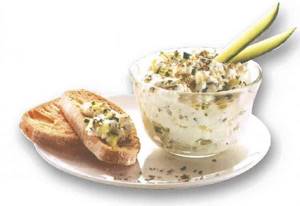
Ingredients:
- Fresh milk 750 ml
- Cucumber 40 g
- Garlic 1 g
- Yogurt 375 ml
- Marjoram 1 tbsp. l.
- Olive oil 1 tbsp. l.
Tzatziki recipe:
- Mix milk and yogurt in the bowl of the device, microwave at 800W for 14 minutes.
- Remove from the microwave, stir and leave for 30 minutes.
- Strain through the machine's colander.
- Place the resulting mass together with a colander in the bowl of the device, cover with a lid, and put in the refrigerator for 1 hour.
- Next, cut the cucumber into small cubes, squeeze out the garlic with a garlic press, add the remaining ingredients and mix well.
- Serve with bread or toast in the toaster.
Step-by-step recipes for homemade cottage cheese from milk - useful tips and secrets
Not every housewife has a lactometer to determine the fat content of milk. There is a solution: you can approximately determine the percentage of fat content by volume. For example: a bottle contains 3 liters of milk. Place it in the refrigerator overnight. By morning, the fat will rise to the top, since its molecules are lighter and larger than liquid. The fatty mass has a slightly creamy tint and is different in color from white milk. All that remains is to measure the volume of fat mass and determine the percentage of milk and fat. If in a bottle with a volume of 3 liters, the third part is a fat “top”, the milk has a fat content of about 10%. This is a good indicator of milk quality.
Domestic cow's milk has the highest fat content in the cold season, when animals are transferred to winter housing. This milk contains 12% fat content. If you need to prepare low-fat cottage cheese, put the milk in the refrigerator for 7-8 hours, then skim off the cream - the raw materials for the cottage cheese are ready.
To speed up the coagulation of milk protein, add calcium chloride to the raw milk. This additive is also used in the dairy industry. It allows you to increase the volume of cheese grains, enriches dairy products with calcium, which passes into whey during pasteurization of milk. Calcium chloride is a cheap drug that is available at any pharmacy without a prescription. Per liter of milk, 0.5 ml of a 5% solution is sufficient. This is literally 2-3 drops of solution. Chloride is an absolutely harmless drug, but it should not be abused. As the great healer said, medicine differs from poison only in dosage.
Goat milk is a very valuable and dietary product. It contains less fat than cow's milk, but goat's milk also has lower coagulability due to the structural features of milk protein. High-quality homemade goat milk cottage cheese can only be obtained using the acid-rennet ripening method.
The dairy industry produces cottage cheese made from reconstituted (powdered) milk, skim milk, but these methods for making cottage cheese at home are complex and require the use of special household appliances and devices.
Cottage cheese is a unique dairy product from which you can prepare a lot of delicious dishes, or you can eat it raw. But in the store it is not always possible to find a quality product that has the proper taste and contains a set of healing ingredients. Therefore, it is worth considering how to prepare cottage cheese at home.
Composition and properties
Cottage cheese is the most common solid milk product, which has been produced in different parts of the world since ancient times. At home, it was traditionally made from sour milk or curdled milk by separating the liquid whey from the solids using a hot or cold method. Modern factory methods differ from folk recipes; store-bought cottage cheese can lose many valuable components, although it is an airy, homogeneous mass that is pleasant to look at, but not necessarily to taste.
The composition of BZHU (proteins, fats, carbohydrates) varies among different varieties of cottage cheese. The fact is that according to standards, it is customary to divide this product into 3 categories of fat content: fat (more than 18%), semi-fat or dietary (9-18%), low-fat (2-9%).
Depending on this, the standard composition of BZHU and the calorie content of a dairy product are as follows:
- fatty: proteins – 15 g, fats – 18 g, carbohydrates – 2.8 g, calorie content 236 kcal/100 g;
- semi-bold: proteins – 18 g, fats – 9 g, carbohydrates – 3 g, calorie content 169 kcal/100 g;
- low-fat: proteins – 22 g, fats – 3 g, carbohydrates – 3.3 g, calorie content 120 kcal/100 g.
Homemade cottage cheese, like other fermented milk products, contains lactic acid and lactose.
These components, together with some enzymes, have a beneficial effect on the stomach and digestion. Among the vitamins, we can note A, C and D, as well as group B. The product also contains useful chemical elements: calcium, phosphorus, iron.
The benefits of cottage cheese are enormous; it is definitely recommended for children during their growth period, the elderly, for fractures, kidney, liver and stomach diseases, rickets, cardiovascular diseases, pregnant and lactating women. Finally, this is simply a nutritious dish that can be used regularly in the diet with virtually no contraindications.
As a source of iron, amino acids and several vitamins, homemade cottage cheese is very useful for enriching bone tissue, stabilizing the nervous system, and preventing metabolism. It has been proven that this product promotes the generation of growth hormone, which is important in childhood and adolescence. Studies prove that cottage cheese burns excess fat and helps with weight loss. It also helps build muscle mass, which is why it is widely popular among weightlifters and is an excellent preventative against atherosclerosis.
Cottage cheese has also been used externally: it is used as compresses for blows, cuts, bruises, and burns. As a cosmetic product, it is also used in the form of creams or masks for the face and body. As you can see, this is a truly universal product.
The harm of cottage cheese has largely not been proven, except perhaps from excessive consumption of the fattiest varieties, which contain large amounts of animal fat and cholesterol.
We are talking about a quality homemade product. This cannot be said about the many questionable cottage cheese products with chemical ingredients that are available in many stores.
Cooking features
There are several ways to cook cottage cheese at home. All of them include the following steps: creating curdled milk from whole milk, heat treatment, squeezing and removing excess liquid. For production, a regular saucepan and stove, water bath, multicooker or microwave are suitable. There is also a cold production method without heat treatment.
In order to make curdled milk from fresh milk, it is best to use glass or earthenware, for subsequent cooking use enamel or galvanized pans, and for further storage any suitable container, for example, plastic containers. For squeezing, you need a piece of clean gauze, for example, medical gauze.
To ferment fresh milk and make curdled milk from it, there are several traditional methods. The main thing is to add an ingredient that contains yeast or acid to promote fermentation. This could be a piece of rye cracker, a couple of spoons of sour cream or a glass of kefir, half a teaspoon of vinegar or citric acid. If you are using homemade cow's or goat's milk rather than store-bought milk, then to be safe, it is better to boil it.
Homemade curdled milk should be stored in a warm place:
near the stove, radiator, behind the refrigerator. Avoid exposure to sunlight, as it destroys beneficial vitamin C. Three days are enough for complete aging under such conditions.
You should not keep the yogurt mixture in the refrigerator, since the milk does not ferment, but simply deteriorates over time.
How to choose raw materials?
Many people admit that village cow's milk is most suitable for making high-quality cottage cheese. It is the fattest, retains all the beneficial ingredients and does not contain additives that prevent fermentation. Not every city dweller has access to it, then it is quite possible to use a store-bought one, but there are a number of nuances here.
- You need to choose a product with a fat content of at least 3.6%.
- Do not buy milk with a long shelf life; most likely, they contain antibiotics that prevent fermentation.
- Don’t be lazy, check production and expiration dates, and purchase only fresh raw materials.
Pasteurized milk from the store is good because in any case it will not be as fatty as natural milk. The cottage cheese made from it is dietary and low-calorie, this is especially true for those people who are on a diet and avoid consuming excess calories.
Country milk is usually boiled before making yogurt and cottage cheese. Boiled or baked milk loses a number of remarkable properties, in particular, even at a temperature of +50 degrees, some useful enzymes and vitamins burn out. But they are unlikely to be present in a store product; factory processing is even more merciless.
To give homemade cottage cheese a special taste, not only curdled milk is used, but also other ingredients that are also of dairy origin. This can be fermented baked milk, kefir, yogurt in various proportions. There are recipes for sourdough with sour cream, which serves as an oxidizing agent for fresh milk.
From the whey remaining after straining out the solid product, you can make delicious okroshka or dough for pancakes or dumplings.



